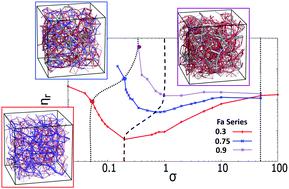当前位置:
X-MOL 学术
›
Soft Matter
›
论文详情
Our official English website, www.x-mol.net, welcomes your feedback! (Note: you will need to create a separate account there.)
Shear stress dependence of force networks in 3D dense suspensions
Soft Matter ( IF 3.4 ) Pub Date : 2021-07-15 , DOI: 10.1039/d1sm00184a Lance E Edens 1 , Enrique G Alvarado , Abhinendra Singh , Jeffrey F Morris , Gregory K Schenter , Jaehun Chun , Aurora E Clark
Soft Matter ( IF 3.4 ) Pub Date : 2021-07-15 , DOI: 10.1039/d1sm00184a Lance E Edens 1 , Enrique G Alvarado , Abhinendra Singh , Jeffrey F Morris , Gregory K Schenter , Jaehun Chun , Aurora E Clark
Affiliation

|
The geometric organization and force networks of 3D dense suspensions that exhibit both shear thinning and thickening have been examined as a function of varying strength of interparticle attractive interactions using lubrication flow discrete element simulations. Significant rearrangement of the geometric topology does not occur at either the local or global scale as these systems transition across the shear thinning and shear thickening regimes. In contrast, massive rearrangements in the balance of attractive, lubrication, and contact forces are observed with interesting behavior of network growth and competition. In agreement with prior work, in shear thinning regions the attractive force is dominant, however as the shear thickening region is approached there is growth of lubrication forces. Lubrication forces oppose the attraction forces, but as viscosity continues to increase under increasing shear stress, the lubrication forces are dominated by contact forces that also resist attraction. Contact forces are the dominant interactions during shear thickening and are an order of magnitude higher than their values in the shear-thinning regime. At high attractive interaction strength, contact networks can form even under shear thinning conditions, however high shear stress is still required before contact networks become the driving mechanism of shear thickening. Analysis of the contact force network during shear thickening generally indicates a uniformly spreading network that rapidly forms across empty domains; however the growth patterns exhibit structure that is significantly dependent upon the strength of interparticle interactions, indicating subtle variations in the mechanism of shear thickening.
中文翻译:

3D 密集悬浮体中力网络的剪切应力依赖性
3D 致密悬浮液的几何组织和力网络表现出剪切稀化和增稠,已使用润滑流离散元素模拟作为粒子间吸引力相互作用强度变化的函数进行了检查。当这些系统跨越剪切变稀和剪切增稠状态时,几何拓扑结构的显着重新排列不会发生在局部或全局尺度上。相比之下,通过网络增长和竞争的有趣行为,观察到吸引力、润滑和接触力平衡的大规模重排。与先前的工作一致,在剪切变薄区域中,吸引力占主导地位,但是随着接近剪切增稠区域,润滑力会增加。润滑力与吸引力相反,但随着剪切应力的增加,粘度继续增加,润滑力受接触力的支配,接触力也抵抗吸引力。接触力是剪切增稠过程中的主要相互作用,并且比剪切变稀状态下的值高一个数量级。在高吸引力相互作用强度下,即使在剪切变薄条件下也可以形成接触网络,但是在接触网络成为剪切增稠的驱动机制之前仍然需要高剪切应力。剪切增稠过程中的接触力网络分析通常表明在空域中快速形成的均匀分布的网络;然而,生长模式表现出的结构显着取决于粒子间相互作用的强度,
更新日期:2021-07-22
中文翻译:

3D 密集悬浮体中力网络的剪切应力依赖性
3D 致密悬浮液的几何组织和力网络表现出剪切稀化和增稠,已使用润滑流离散元素模拟作为粒子间吸引力相互作用强度变化的函数进行了检查。当这些系统跨越剪切变稀和剪切增稠状态时,几何拓扑结构的显着重新排列不会发生在局部或全局尺度上。相比之下,通过网络增长和竞争的有趣行为,观察到吸引力、润滑和接触力平衡的大规模重排。与先前的工作一致,在剪切变薄区域中,吸引力占主导地位,但是随着接近剪切增稠区域,润滑力会增加。润滑力与吸引力相反,但随着剪切应力的增加,粘度继续增加,润滑力受接触力的支配,接触力也抵抗吸引力。接触力是剪切增稠过程中的主要相互作用,并且比剪切变稀状态下的值高一个数量级。在高吸引力相互作用强度下,即使在剪切变薄条件下也可以形成接触网络,但是在接触网络成为剪切增稠的驱动机制之前仍然需要高剪切应力。剪切增稠过程中的接触力网络分析通常表明在空域中快速形成的均匀分布的网络;然而,生长模式表现出的结构显着取决于粒子间相互作用的强度,



























 京公网安备 11010802027423号
京公网安备 11010802027423号